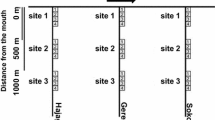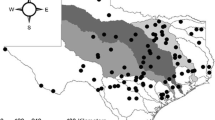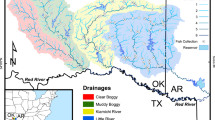Abstract
Nestedness of faunal assemblages is a multi-scale phenomenon, potentially influenced by a variety of factors. Prior small-scale studies have found freshwater fish species assemblages to be nested along stream courses as a result of either selective colonization or extinction. However, within-stream gradients in temperature and other factors are correlated with the distributions of many fish species and may also contribute to nestedness. At a regional level, strongly nested patterns would require a consistent set of structuring mechanisms across streams, and correlation among species’ tolerances of the environmental factors that influence distribution. Thus, nestedness should be negatively associated with the spatial extent of the region analyzed and positively associated with elevational gradients (a correlate of temperature and other environmental factors). We examined these relationships for the freshwater fishes of Virginia. Regions were defined within a spatial hierarchy and included whole river drainages, portions of drainages within physiographic provinces, and smaller subdrainages. In most cases, nestedness was significantly stronger in regions of smaller spatial extent and in regions characterized by greater topographic relief. Analysis of hydrologic variability and patterns of faunal turnover provided no evidence that inter-annual colonization/extinction dynamics contributed to elevational differences in nestedness. These results suggest that, at regional scales, nestedness is influenced by interactions between biotic and abiotic factors, and that the strongest nestedness is likely to occur where a small number of organizational processes predominate, i.e., over small spatial extents and regions exhibiting strong environmental gradients.





Similar content being viewed by others
References
Angermeier PL, Schlosser IJ (1989) Species-area relationships for stream fishes. Ecology 70:1450–1462
Angermeier PL, Winston MR (1998) Local vs. regional influences of local diversity in stream fish communities of Virginia. Ecology 79:911–927
Angermeier PL, Winston MR (1999) Characterizing fish community diversity across Virginia landscapes: prerequisite for conservation. Ecol Appl 9:335–349
Bolger DT, Alberts AC, Soulé ME (1991) Occurrence patterns of bird species in habitat fragments: sampling, extinctions, and nested species subsets. Am Nat 137:155–166
Burton GW, Odum EP (1945) The distribution of stream fish in the vicinity of Mountain Lake, Virginia. Ecology 26:182–194
Butaye J, Jacquemyn H, Hermy M (2001) Differential colonization causing non-random forest plant community structure in a fragmented agricultural landscape. Ecography 24:369–380
Calmé S, Desrochers A (1999) Nested bird and micro-habitat assemblages in a peatland archipelago. Oecologia 118:361–370
Conover WJ (1980) Practical nonparametric statistics, 2nd edn. Wiley, New York
Cook RR (1995) The relationship between nested subsets, habitat subdivision, and species diversity. Oecologia 101:204–210
Cook RR, Quinn JF (1995) The influence of colonization in nested species subsets. Oecologia 102:413–424
Frissell CA, Liss WA, Warren CE, Hurley MD (1986) A hierarchical framework for stream habitat classification: viewing streams in a watershed context. Environ Manage 10:199–214
Gaston K (2000) Global patterns in biodiversity. Nature 405:220–227
Herlihly AT, Stoddard JL, Johnson CB (1998) The relationship between stream chemistry and watershed land cover data in the mid-Atlantic region, US. Water Air Soil Pollut 105:377–386
Hocutt CH, Wiley EO (1986) The zoogeography of North American freshwater fishes. Wiley, New York
Horwitz RJ (1978) Temporal variability patterns and the distributional patterns of stream fishes. Ecol Monogr 48:307–321
Hubbell SP (2001) The unified theory of biodiversity and biogeography. Princeton University Press, Princeton
Hynes HBN (1970) The ecology of running waters. University of Toronto Press, Toronto
Imhoff JG, Fitzgibbon J, Annable WK (1996) A hierarchical evaluation system for characterizing watershed ecosystems for fish habitat. Can J Fish Aquat Sci 53:312–326
Jenkins RE, Burkhead NM (1994) Freshwater fishes of Virginia. American Fisheries Society, Bethesda
Kadmon R (1995) Nested species subsets and geographic isolation: a case study. Ecology 76:458–465
Kodric-Brown A, Brown JH (1993) Highly structured fish communities in Australian desert springs. Ecology 74:1847–1855
Matthews WJ (1998) Patterns in freshwater fish ecology. Chapman and Hall, New York
Menge BA, Olson AM (1990) Role of scale and environmental factors in regulation of community structure. Trends Ecol Evol 5:46–47
Patterson BD (1987) The principle of nested subsets and its implications for biological conservation. Conserv Biol 1:247–293
Patterson BD, Atmar W (1986) Nested subsets and the structure of insular mammalian faunas and archipelagos. Biol J Linn Soc 28:65–82
Patterson BD, Brown JH (1991) Regionally nested patterns of species composition in grainivorous rodent assemblages. Biogeography 18:395–402
Poff NL (1997) Landscape filters and species traits: towards mechanistic understanding and prediction in stream ecology. J North Am Benthol Soc 16:391–409
Quinn JF, Hastings A (1987) Extinction in subdivided habitats. Conserv Biol 1:198–208
Rahel FJ, Hubert WA (1991) Fish assemblages and habitat gradients in a Rocky Mountain—Great Plains stream: biotic zonation and additive patterns of community change. Trans Am Fish Soc 120:319–332
Ricklefs RE, Schluter D (1993) Species diversity: regional and historic influences. In: Ricklefs RE, Schluter D (eds) Species diversity in ecological communities: historical and geographic perspectives. University of Chicago Press, Chicago, pp 350–363
Schlosser IJ (1987) A conceptual framework for fish communities in small warmwater streams. In: Matthews WJ, Heins DC (eds) Community and evolutionary ecology of North American stream fishes. University of Oklahoma Press, Norman, Oklahoma, pp 17–28
Schlosser IJ (1991) Stream fish ecology: a landscape perspective. BioScience 41:704–712
Sheldon AL (1968) Species diversity and longitudinal succession in stream fishes. Ecology 49:193–198
Strahler AN (1952) Hypsometric (area-altitude) analysis of erosional topography. Bull Geol Soc Am 63:1117–1142
Swanson FJ, Krantz TK, Caine N, Woodmansee RG (1988) Landform effects on ecosystem processes and regional patterns. Freshw Biol 36:92–98
Taylor CM (1997) Fish species richness and incidence patterns in isolated and connected stream pools: effects of pool volume and spatial position. Oecologia 110:560–566
Taylor CM, Warren ML Jr (2001) Dynamics in species composition of stream fish assemblages: environmental variability and nested subsets. Ecology 82:2320–2330
United States Environmental Protection Agency (1998) USEPA Office of Water, River Reach File 3 (RF3) Alpha for CONUS, Hawaii, Puerto Rico, and the US Virgin Islands. Edition 3 alpha
United States Geological Survey (1980) Hydrologic Unit Map—1974; State of Virginia. US Geological Survey, Reston
Vannote RL, Minshall GW, Cummins KW, Sedell JR, Cushing CE (1980) The river continuum concept. Can J Fish Aquat Sci 37:130–137
Wiens JA, Addicott JF, Case TJ, Diamond J (1986) Overview: the importance of spatial and temporal scale in ecological investigations. In: Diamond J, Case TJ (eds) Community ecology. Harper and Row, New York, pp 145–153
Worthen WB, Carswell ML, Kelly KA (1996) Nested subset structure of larval mycophagous fly assemblages: nestedness in a non-island system. Oecologia 107:257–264
Wright DH, Reeves J (1992) On the meaning and measurement of nestedness of species assemblages. Oecologia 92:416–428
Wright DH, Patterson BD, Mikkelson GM, Cutler A, Atmar W (1998) A comparative analysis of nested subset patterns of species composition. Oecologia 113:1–20
Acknowledgments
We thank Lenwood Hall (University of Maryland), Paul Kazyak (Maryland Department of Natural Resources), Peter Ruhl (United States Geological Survey), and Vann Stancil (Virginia Polytechnic and State University) for providing data to examine inter-annual variation in fish community composition. Two anonymous reviewers provided comments that significantly improved an earlier version of this manuscript. K.L. Krueger was supported partly by a Federal Aid grant from the Virginia Department of Game and Inland Fisheries.
Author information
Authors and Affiliations
Corresponding author
Additional information
The Virginia Cooperate Fish and Wildlife Research Unit is jointly sponsored by United States Geological Survey, Virginia Polytechnic Institute and State University, and Virginia Department of Game and Inland Fisheries.
Rights and permissions
About this article
Cite this article
Cook, R.R., Angermeier, P.L., Finn, D.S. et al. Geographic variation in patterns of nestedness among local stream fish assemblages in Virginia. Oecologia 140, 639–649 (2004). https://doi.org/10.1007/s00442-004-1618-z
Received:
Accepted:
Published:
Issue Date:
DOI: https://doi.org/10.1007/s00442-004-1618-z




